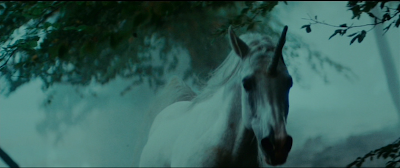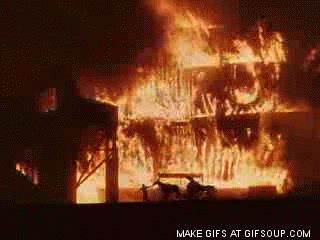Duel to the Death (1983)
dir. Siu-Tung Ching
Star Trek: The Next Generation "Where No One Has Gone Before" (1987)
dir. Rob Bowman
Trek cap from the great Not Paying Attention to Star Trek.
Saturday, March 31, 2012
Tuesday, March 27, 2012
The Message in Skin
The Exorcist (1973)
dir. William Friedkin
A Nightmare on Elm Street 3: Dream Warriors (1987)
dir. Chuck Russell
dir. William Friedkin
A Nightmare on Elm Street 3: Dream Warriors (1987)
dir. Chuck Russell
Monday, March 26, 2012
Sunday, March 25, 2012
The Unicorn
dir. Ridley Scott
Blade Runner: Director's Cut (1992)
dir. Ridley Scott
Movie legend holds that the unicorn insert was leftover footage from Legend. Paul M. Sammon maintains that it was original BR test footage from 1982.
Saturday, March 24, 2012
Forced Panorama #1
Vampyr (1932)
dir. Carl Th. Dreyer
Panorama from five stills of a whip-pan in Carl Dreyer's Vampyr. Monstrous original size after the jump.
dir. Carl Th. Dreyer
Panorama from five stills of a whip-pan in Carl Dreyer's Vampyr. Monstrous original size after the jump.
Friday, March 23, 2012
The Shirt
Arrested Development "My Mother the Car" (2003)
dir. Jay Chandrasekhar
30 Rock "The Fabian Strategy" (2010)
dir. Beth McCarthy-Miller
dir. Jay Chandrasekhar
30 Rock "The Fabian Strategy" (2010)
dir. Beth McCarthy-Miller
Wednesday, March 21, 2012
The Bombs
Victory Through Air Power (1942)
dir. Perce Pearce, James Algar, Clyde Geronimi, Jack Kinney, and H.C. Potter
Pearl Harbor (2001)
dir. Michael Bay
dir. Perce Pearce, James Algar, Clyde Geronimi, Jack Kinney, and H.C. Potter
Pearl Harbor (2001)
dir. Michael Bay
Tuesday, March 20, 2012
The Fire
Gone with the Wind (1939)
dir. Victor Fleming
The Walking Dead "Beside the Dying Fire" (2012)
dir. Ernest K. Dickerson
dir. Victor Fleming
The Walking Dead "Beside the Dying Fire" (2012)
dir. Ernest K. Dickerson
The Ghost Exterminators
Lonesome Ghosts (1937)
dir. Burt Gillett
Ghostbusters (1984)
dir. Ivan Reitman
"I ain't a-scared of no ghosts!"
Thursday, March 15, 2012
Wednesday, March 14, 2012
The City of New York (2)
Little Fugitive (1953)
dir. Ray Ashley, Morris Engel, & Ruth Orkin
Lovers & Lollipops (1956)
dir. Morris Engel
dir. Ray Ashley, Morris Engel, & Ruth Orkin
Lovers & Lollipops (1956)
dir. Morris Engel
Tuesday, March 13, 2012
Some Stray Thoughts About 2001 #2
Part 1
2001 obsesses over a peculiar kind of isolation - compartmentalization. As often as not, characters interact through screens:
2001 obsesses over a peculiar kind of isolation - compartmentalization. As often as not, characters interact through screens:
Even when they're in the same room, their cold professional distance is emphasized by visual compartments, like the white light-boxes separating Dr. Floyd and his colleagues:
We people, in this future, can be face to face and a million miles away, as cleanly divided and rigidly formatted as the astronauts' meals:
Or, even more horrifyingly apt, the inorganic blocks displayed beside (and visually dominated by) HAL 9000. Here we see one of the unseen, unmourned lost astronauts sealed up in a spacesuit/coffin within a bed/coffin within a screen/coffin:
This shot is probably the "warmest" grouping of people in the film:
So it's hard for me to not view this little vignette as a horror scene.
And their very presence is strange, isn't it? They're an odd, dull bunch who seem to exist only to color in the society of 2001. We don't get much explicit information about the social order in this future, but their rigid postures and hawkish eyes reveal a lot. They're the idle rich, and they're as haughty and cold in 2001's future as they were in Barry Lyndon's past. Behind them, a working man is locked away in a glass cubicle that's as remote and joyless as any prison cell.
It seems like social castes are strong in 2001. I've already mentioned that Dr. Floyd's two empty flights speak a lot about the loneliness of life in space, but they also speak to the exclusivity of space travel.
He's bookended by the living dead - those deeply disturbing graves-within-graves spacesuits-within-spaceships sleep pods which seem more and more to be a central image of the film. But Poole doesn't even notice them. They're alive but they're not, they're there but they're not, they're in the same room but they're not. His parents wish him a happy birthday and present a cake he can never eat and burning candles he can never blow out. They speak to each other but they don't.
Poole and Bowman are privileged men, and their relationship with HAL 9000 plays like old money talking to their butler. Bowman speculates on the robot's psychology:
"Well, he acts like he has genuine emotions. Of course, he's programmed that way to make it easier for us to talk to him. But as to whether or not he has real feelings is something I don't think anyone can truthfully answer."It reminds me of that scene in Archer when Sterling reacts with horror when his butler Woodhouse sits at the table - "he thinks he's people!"
The irony here is that HAL has been programmed to affect emotions, while the sedate astronauts have been programmed by training to suppress theirs. The organic beings and the mechanical are thus opposed philosophically, and everything is destroyed because of miscommunication and mistrust. The conflict is between two beings who cannot even begin to relate to one another. It's nice and symmetrical that HAL's plan to discover the fault in the AE-35 unit - let it fail and then run a failure-mode analysis - is basically exactly the plan to deal with HAL itself that Poole and Bowman come up with in the EVA pod.
The final shot of 2001 is one of ultimate loneliness - the loneliness of a God. It's a powerful and important image, but the shot that strikes me most comes when Dave Bowman repairs that plot-critical AE-35 unit. HAL believes it will fail, but it does not. It's a small mistake, a totally trivial error on a small piece of machinery, but it is unforgivable to the astronauts and this rigid refusal to communicate results in the useless deaths of all parties involved.
Bowman, about to remove the unit, floats through the void, presses a button, and shields his eyes from the sun:
This is the essence of 2001: A Space Odyssey - floating alone through the universe, slowly obscuring your face. Shut in and shut out, separated from the world around you and from your own body as well. That black and lifeless helmet is as philosophically disturbing an image as I've ever seen in a film.
Subscribe to:
Posts (Atom)

















































